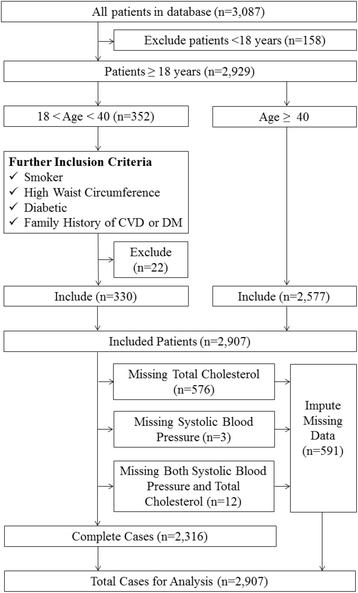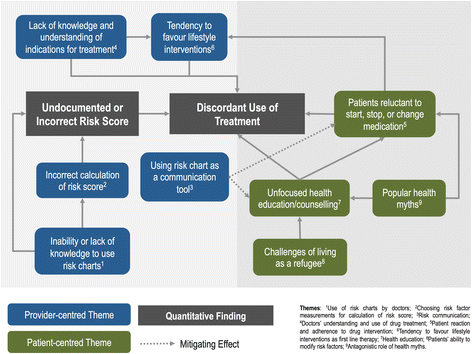Cardiovascular disease risk and prevention amongst Syrian refugees: mixed methods study of Médecins Sans Frontières programme in Jordan
- PMID: 28725259
- PMCID: PMC5512828
- DOI: 10.1186/s13031-017-0115-z
Cardiovascular disease risk and prevention amongst Syrian refugees: mixed methods study of Médecins Sans Frontières programme in Jordan
Abstract
Background: The growing burden of non-communicable diseases (NCDs) presented new challenges for medical humanitarian aid and little was known about primary health care approaches for these diseases in humanitarian response. We aimed to evaluate Médecins Sans Frontières (MSF's) use of total CVD risk based prevention strategies amongst Syrian refugees in northern Jordan to identify opportunities to improve total CVD risk based guidance for humanitarian settings.
Methods: We evaluated CVD risk assessment and management in two outpatient NCD clinics in the Irbid governorate of Jordan using a mixed methods design with qualitative and quantitative strands of equal priority, integrated during data collection and interpretation. World Health Organisation/International Society of Hypertension (WHO/ISH) CVD risk charts requiring measured cholesterol were used in the clinics and in our analysis. An electronic database of routine clinical information was used to determine the CVD risk profile of the clinic population, the pattern and concordance of lipid-lowering treatment prescriptions, and the prevalence and accuracy of documented CVD risk scores. This was combined with semi-structured interviews with MSF health workers, which were recorded, transcribed verbatim, and analysed thematically.
Results: We reviewed the clinical records of 2907 patients. One fifth (20.9%; 95% CI 19.5, 22.4) of patients had a history of CVD while 56.8% (95% CI 54.9, 58.6) of patients had a WHO/ISH risk of <10%. Only 23.3% (95% CI 21.9, 25.0) of patients had a documented WHO/ISH risk score of which 65% were correct. 60.4% (95% CI 58.6, 62.2) of patients were eligible for lipid-lowering treatment and 48.3% (95% CI 45.9, 50.6) of these patients were prescribed it. Analysis of interviews with sixteen MSF staff identified nine explanatory themes. Providers had confusion about when and how to use the risk charts, tended to favour lifestyle intervention over drug treatment, and had uncertainty about the role of lipid-lowering treatment in primary but not secondary prevention. Patients were reluctant to start, stop, or change medication and were less able to modify risk factors and benefit from health education because of their social and economic context.
Conclusions: Four priority areas to improve CVD risk-based guidance for prevention in humanitarian settings include: practical training for health workers on total CVD risk assessment and associated guidance; supporting the use of CVD risk charts as a communication tool and task sharing; contextualising risk scoring in a broader, single consultation, total CVD risk-based algorithm; and targeting popular health myths amongst the community.
Keywords: Cardiovascular disease; Cardiovascular risk assessment; Jordan; Primary health care; Refugee; Syria; WHO PEN; World Health Organisation Package of Essential NCD Interventions for Primary Health Care in Low Resource Settings.
Figures
References
-
- WHO. Adressing noncommunicable diseases in emergencies [Internet]. 2015 [cited 2016 Nov 28]. Available from: http://www.who.int/features/2015/ncd-emergencies-ukraine/en/.
-
- Demaio A, Jamieson J, Horn R, de Courten M, Tellier S. Non-communicable diseases in emergencies: a call to action. Plos Curr. 2013;5. https://www.ncbi.nlm.nih.gov/pubmed/?term=24056956. - PMC - PubMed
Grants and funding
LinkOut - more resources
Full Text Sources
Other Literature Sources
Miscellaneous



